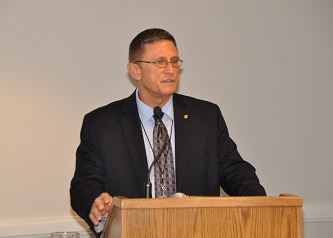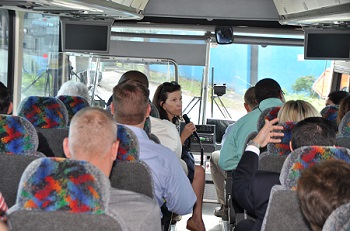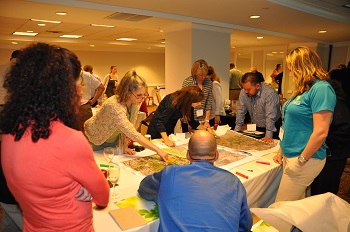Take a look out your window — what do you see? Likely roads, trees, buildings, perhaps some green space and people going about their daily routines. Most of us would regard this as an unremarkable everyday American tableau. Leaders at Miami-Dade County’s Department of Parks, Recreation and Open Space (PROS), however, view scenes like this through an entirely different lens.
To them, our public spaces, commerce centers, schools, health care facilities, transportation infrastructure and park and recreation systems compose a modern, interconnected network that forms a web of opportunities to improve the quality of residents’ lives. Their concepts of place-making through strategic policies, programs and partnerships to encourage healthier lifestyles was the focus of NRPA’s first Innovation Lab, held March 12-13 in Miami, Florida.
By now we all know the grim statistics — only 19 percent of Americans get the recommended daily allotment of physical activity. There is an epidemic of obesity, Type-II Diabetes and hypertension in children — diseases traditionally reserved for middle-aged adults. These same children are facing a future where their life expectancies may be shorter than that of their parents unless major changes happen across multiple sectors of our society.
 It was against this grim backdrop that Miami-Dade PROS Director Jack Kardys, Maria Nardi, chief of planning at Miami-Dade County PROS and other partners endeavored to craft a 50-year master plan that would see their county become one of the most forward-thinking in the country when it comes to engineering for equitable health outcomes. “The open space master plan…shapes how we approach things as a culture,” Kardys said in front of a room of almost 30 attendees at Miami’s iconic Mayfair Hotel. “Miami-Dade County, as a result of that plan, adopted the idea that parks are not just a destination — they’re a metaphor for a healthy environment, with the public realm, natural spaces, cultural spaces, greenways and blueways tying it all together.” Essentially, if you’re a park and recreation professional in Kardys’ system, you’re a health care provider as well.
It was against this grim backdrop that Miami-Dade PROS Director Jack Kardys, Maria Nardi, chief of planning at Miami-Dade County PROS and other partners endeavored to craft a 50-year master plan that would see their county become one of the most forward-thinking in the country when it comes to engineering for equitable health outcomes. “The open space master plan…shapes how we approach things as a culture,” Kardys said in front of a room of almost 30 attendees at Miami’s iconic Mayfair Hotel. “Miami-Dade County, as a result of that plan, adopted the idea that parks are not just a destination — they’re a metaphor for a healthy environment, with the public realm, natural spaces, cultural spaces, greenways and blueways tying it all together.” Essentially, if you’re a park and recreation professional in Kardys’ system, you’re a health care provider as well.
During a day of presentations from some of Kardys’ strategic Miami-based partners, as well as health leaders from across the country, Innovation Lab attendees got an in-depth look at how their hosts have shifted the paradigm to present parks as not just places for aerobics classes or picnics, but essential components of a healthy community. They were invited to consider how they might make the case to their own elected bodies and patrons that, although municipal budgets are tight, priority should be put on the parks departments and professionals who arguably have greater influence over the health of their patrons than any single heath care provider.
To illustrate natural connectedness of parks, health providers, land use and social equity, Joanna Lombard, professor at the University of Miami School of Architecture, and Dr. Lillian Rivera of the Florida Department of Health, took our group on a field trip to Liberty City, traditionally one of the most underserved communities in Miami-Dade County. Recently it was the recipient of the new Frederica Wilson/Juanita Mann Health Center and last year enjoyed a visit from First Lady Michelle Obama to its Gwen Cherry Park, an almost 40-acre parcel just adjacent to the center. It’s also the subject of a study by Lombard’s students who are considering how to connect patrons of the health center to Gwen Cherry Park, as the two are currently separated by an active railroad track, industrial areas and brownfields that are unfriendly or impassible to pedestrians. Lombard, Kardys and their colleagues at the Miller School of Medicine and Miami University want to see the area revitalized to track with the county master plan, so that residents can see and enjoy the benefits of accessible health care connected to a place to get fit, stay healthy and enjoy nature.
trip to Liberty City, traditionally one of the most underserved communities in Miami-Dade County. Recently it was the recipient of the new Frederica Wilson/Juanita Mann Health Center and last year enjoyed a visit from First Lady Michelle Obama to its Gwen Cherry Park, an almost 40-acre parcel just adjacent to the center. It’s also the subject of a study by Lombard’s students who are considering how to connect patrons of the health center to Gwen Cherry Park, as the two are currently separated by an active railroad track, industrial areas and brownfields that are unfriendly or impassible to pedestrians. Lombard, Kardys and their colleagues at the Miller School of Medicine and Miami University want to see the area revitalized to track with the county master plan, so that residents can see and enjoy the benefits of accessible health care connected to a place to get fit, stay healthy and enjoy nature.
 Back at the hotel, Innovation Lab attendees split into four groups, assimilated the information gathered during the site visit and workshopped their own solutions to connect and revitalize this area of Liberty City. For purposes of the exercise, they were given an unlimited budget and encouraged to forget the typical restraints of feasibility and instead focus on creating an ideal landscape that would promote walking, safety and deeper social connections among residents. It took a few minutes for the concept of “unlimited budget/unlimited possibilities” to sink in for a group so accustomed to being told “no,” but soon all were deeply involved in realizing their ideal visions. It was clear this group had made the connections Kardys and Lombard were advocating and were themselves energized by being given permission to imagine a park system as more than a playground or place to walk the dog. These high-level park and recreation professionals clearly saw the possibilities before them, as well as the challenge of communicating similar visions to their home constituencies.
Back at the hotel, Innovation Lab attendees split into four groups, assimilated the information gathered during the site visit and workshopped their own solutions to connect and revitalize this area of Liberty City. For purposes of the exercise, they were given an unlimited budget and encouraged to forget the typical restraints of feasibility and instead focus on creating an ideal landscape that would promote walking, safety and deeper social connections among residents. It took a few minutes for the concept of “unlimited budget/unlimited possibilities” to sink in for a group so accustomed to being told “no,” but soon all were deeply involved in realizing their ideal visions. It was clear this group had made the connections Kardys and Lombard were advocating and were themselves energized by being given permission to imagine a park system as more than a playground or place to walk the dog. These high-level park and recreation professionals clearly saw the possibilities before them, as well as the challenge of communicating similar visions to their home constituencies.
It may take a while for the holistic concepts discussed during the Miami Innovation Lab to take root across America, but you can spot the trend growing. Five hundred park sites across the country will implement the HEPA standards advocated through the Commit to Health initiative, which supports healthy eating and physical activity. Dozens of agencies, including Miami-Dade PROS, are exploring the possibilities of Park Prescriptions, a concept that links the healthcare system and public lands, including parks, to combat disease. And more than two dozen agencies will undoubtedly benefit from the insights brought home from their representatives who attended NRPA’s first Innovation Lab.
Take a closer look at the Miami agenda, photos and video (coming soon) from the event. NRPA is in the process of planning future Innovation Labs across the country, so stay tuned for more information as it becomes available.
How can we ensure that parks and recreation professionals become solution providers for myriad public health concerns? What are the specific policies, programs and partnerships that can be leveraged in your communities to create a greater culture of health?
Leave a comment below or tweet us at @NRPA_News #NRPAInnovation.
Samantha Bartram is NRPA's Associate Editor of Parks & Recreation magazine.

